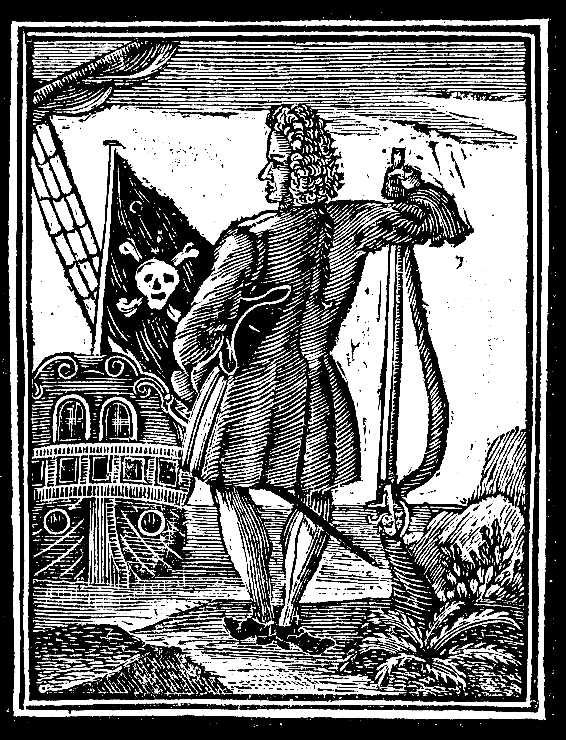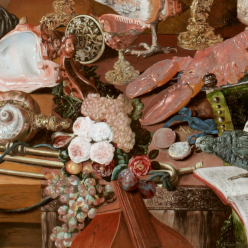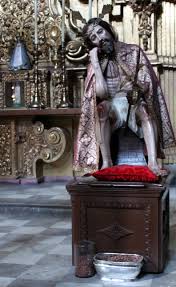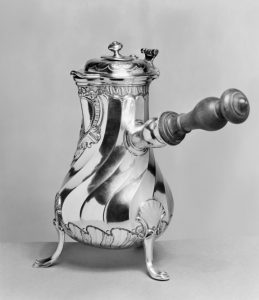
Artist Unknown, London, 1724.
Print engraving.
From Captain Charles Johnson’s A General History of the Pyrates, in the Library of Congress Rare Book and Special Collections Division Washington.
This engraving shows the notorious pirate Captain Stede Bonnet, one of many pirates whose lives Captain Charles Johnsons details in his book, A General History of the Pyrates. Bonnet stands before his ship, the Revenge. Upon its mast flies Bonnet’s version of the much-feared Jolly Roger, a black flag with a skull, crossbones, and dagger. Like many of his contemporaries, Bonnet incorporated symbols of death onto the banner he flew.
The first appearance of the Jolly Roger was recorded in 1700, during the early years of the peak of the Golden Age of Piracy. Captain Emmanuel Wynn reportedly flew it while in the Caribbean. The name Jolly Roger has two possible origins: it could come from either 1.) la jolie rouge, a French phrase meaning “pretty red,” or 2.) Old Roger, a nickname for the devil; it could also come from some combination of the two phrases. Before the Jolly Roger became the official flag of pirates sailing in the Caribbean Sea and Atlantic Ocean, many flew a red flag, hence the French. As piracy became pervasive, pirates were associated with the devil for their violence and success in raiding European ships, hence the nickname. Thus, the black flag with its deathly symbolism found its moniker in the association with the previous pirate flag and the devil those who flew it evoked.
While the Jolly Roger united pirates under it, most pirate captains had their own version of the banner. “Black” Sam Bellamy and Edward England, for example, used the classic skull with crossbones underneath, while Francis Spriggs displayed a skeletal figure holding a spear and hourglass, and Jack “Calico” Rackham had a skull with crossed swords underneath it. Each captain had his own ship or fleet, and those in their crews pledged loyalty first to their captain, and then to the piratical ideal.
What was the piratical ideal? Why did so many sailors jump ship from British or French navies and merchant fleets and instead pledge loyalty to the Jolly Roger? The black flag lured many sailors to it with three promises: economic success, democratic governance, and vengeance. Some sailors turned to piracy after a history of privateering, a get-rich-quick scheme that was the legal version of piracy—so long as European states were willing to employ the sailors. Others turned to piracy because life aboard merchant, slave, and navy ships was unbearable—punishments were incredibly harsh for crew members sailing underneath English captains. More still turned on the European powers because most pirate crews were very democratic—they had the option to depose their captain if he was unsatisfactory and spoils were neatly divided amongst every crew member. Finally, almost all were drawn by the promise of justice—for the conditions they suffered upon the British ships or the abrupt unemployment they were dealt after the War of the Spanish Succession.
The Jolly Roger united sailors into a nation of outlaws, but the European states, particularly the English, ultimately created that nation. They drove away hundreds of sailors, whose only recourse was to don a mask of violence and attempt to invoke the devil as they attacked the countries that had wronged them.
Sources:
Image: Artist Unknown. “Major Stede Bonnet.” In A General History of the Pyrates by Captain Charles Johnson, print engraving. London: T. Warner, 1724. https://www.ncdcr.gov/blog/2015/09/27/a-pirates-life-was-his-stede-bonnets
Johnson, Charles. A General History of the Pyrates: from Their First Rise and Settlement in the Island of Providence to the Present Time. London: T. Warner, 1724. http://find.galegroup.com.avoserv2.library.fordham.edu/ecco/retrieve.do?scale=0.50&sort=Author&docLevel=FASCIMILE&prodId=ECCO&tabID=T001&resultListType=RESULT_LIST&qrySerId=Locale%28en%2C%2C%29%3AFQE%3D%28BN%2CNone%2C7%29T072262%24&retrieveFormat=MULTIPAGE_DOCUMENT&inPS=true&userGroupName=nysl_me_fordham&docId=CW3301317417¤tPosition=1&workId=0442400200&relevancePageBatch=CW101317343&contentSet=ECCOArticles&callistoContentSet=ECCOArticles&resultListType=RESULT_LIST&reformatPage=N&retrieveFormat=MULTIPAGE_DOCUMENT&scale=0.50&pageIndex=74&orientation=&showLOI=&quickSearchTerm=&stwFuzzy=&doDirectDocNumSearch=false&searchId=
Kuhn, Gabriel. Life Under the Jolly Roger: Reflections on the Golden Age of Piracy. Oakland: PM Press, 2010. http://eds.b.ebscohost.com.avoserv2.library.fordham.edu/eds/ebookviewer/ebook/bmxlYmtfXzMwNTQ4Ml9fQU41?sid=3e53900f-4780-4be1-b625-4311f476dc6e@pdc-v-sessmgr02&vid=3&format=EB&rid=7
Pringle, Patrick. Jolly Roger: The Story of the Great Age of Piracy. San Francisco: Dover Publications, 2012. https://books.google.com/books?hl=en&lr=&id=OQj17APXUUUC&oi=fnd&pg=PA9&dq=jolly+roger&ots=7BgMJ6rh_N&sig=zob5DlmAOo171XbX1agJiRmiHr4#v=onepage&q=jolly%20roger&f=false
Rediker, Marcus. “‘Under the Banner of King Death’: The Social World of Anglo-American Pirates, 1716 to 1726.” The William and Mary Quarterly 38, no. 2 (April 1981) https://www-jstor-org.avoserv2.library.fordham.edu/stable/1918775?seq=8#?


